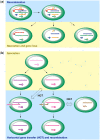The Landscape of Recombination Events That Create Nonribosomal Peptide Diversity
- PMID: 33480992
- PMCID: PMC8097286
- DOI: 10.1093/molbev/msab015
The Landscape of Recombination Events That Create Nonribosomal Peptide Diversity
Abstract
Nonribosomal peptides (NRP) are crucial molecular mediators in microbial ecology and provide indispensable drugs. Nevertheless, the evolution of the flexible biosynthetic machineries that correlates with the stunning structural diversity of NRPs is poorly understood. Here, we show that recombination is a key driver in the evolution of bacterial NRP synthetase (NRPS) genes across distant bacterial phyla, which has guided structural diversification in a plethora of NRP families by extensive mixing and matching of biosynthesis genes. The systematic dissection of a large number of individual recombination events did not only unveil a striking plurality in the nature and origin of the exchange units but allowed the deduction of overarching principles that enable the efficient exchange of adenylation (A) domain substrates while keeping the functionality of the dynamic multienzyme complexes. In the majority of cases, recombination events have targeted variable portions of the Acore domains, yet domain interfaces and the flexible Asub domain remained untapped. Our results strongly contradict the widespread assumption that adenylation and condensation (C) domains coevolve and significantly challenge the attributed role of C domains as stringent selectivity filter during NRP synthesis. Moreover, they teach valuable lessons on the choice of natural exchange units in the evolution of NRPS diversity, which may guide future engineering approaches.
Keywords: evolution; microbial ecology; natural products; nonribosomal peptide synthetases; recombination; structural diversity.
© The Author(s) 2021. Published by Oxford University Press on behalf of the Society for Molecular Biology and Evolution.
Figures






Similar articles
-
Recent progress in the reprogramming of nonribosomal peptide synthetases.J Pept Sci. 2024 Mar;30(3):e3545. doi: 10.1002/psc.3545. Epub 2023 Sep 18. J Pept Sci. 2024. PMID: 37721208 Review.
-
Beyond Toxin Transport: Novel Role of ABC Transporter for Enzymatic Machinery of Cereulide NRPS Assembly Line.mBio. 2020 Sep 29;11(5):e01577-20. doi: 10.1128/mBio.01577-20. mBio. 2020. PMID: 32994334 Free PMC article.
-
Nonribosomal peptide synthesis in Aspergillus fumigatus and other fungi.Microbiology (Reading). 2007 May;153(Pt 5):1297-1306. doi: 10.1099/mic.0.2006/006908-0. Microbiology (Reading). 2007. PMID: 17464044 Review.
-
Chemical Strategies for Visualizing and Analyzing Endogenous Nonribosomal Peptide Synthetase (NRPS) Megasynthetases.Chembiochem. 2019 Aug 16;20(16):2032-2040. doi: 10.1002/cbic.201900186. Epub 2019 Jul 22. Chembiochem. 2019. PMID: 31134733 Review.
-
An Orphan MbtH-Like Protein Interacts with Multiple Nonribosomal Peptide Synthetases in Myxococcus xanthus DK1622.J Bacteriol. 2018 Oct 10;200(21):e00346-18. doi: 10.1128/JB.00346-18. Print 2018 Nov 1. J Bacteriol. 2018. PMID: 30126939 Free PMC article.
Cited by
-
Chromosome architecture as a determinant for biosynthetic diversity in Micromonospora.Microb Genom. 2024 Nov;10(11):001313. doi: 10.1099/mgen.0.001313. Microb Genom. 2024. PMID: 39499242 Free PMC article.
-
Recent Advances in Biocatalysis for Drug Synthesis.Biomedicines. 2022 Apr 21;10(5):964. doi: 10.3390/biomedicines10050964. Biomedicines. 2022. PMID: 35625702 Free PMC article. Review.
-
Charting the Lipopeptidome of Nonpathogenic Pseudomonas.mSystems. 2023 Feb 23;8(1):e0098822. doi: 10.1128/msystems.00988-22. Epub 2023 Jan 31. mSystems. 2023. PMID: 36719227 Free PMC article.
-
Integrated Genomic and Metabolomic Analysis Illuminates Key Secreted Metabolites Produced by the Novel Endophyte Bacillus halotolerans Cal.l.30 Involved in Diverse Biological Control Activities.Microorganisms. 2022 Feb 9;10(2):399. doi: 10.3390/microorganisms10020399. Microorganisms. 2022. PMID: 35208854 Free PMC article.
-
Bifurcation drives the evolution of assembly-line biosynthesis.Nat Commun. 2022 Jun 17;13(1):3498. doi: 10.1038/s41467-022-30950-z. Nat Commun. 2022. PMID: 35715397 Free PMC article.
References
-
- Ackerley DF. 2016. Cracking the nonribosomal code. Cell Chem Biol. 23(5):535–537. - PubMed
-
- Alanjary M, Cano-Prieto C, Gross H, Medema MH.. 2019. Computer-aided re-engineering of nonribosomal peptide and polyketide biosynthetic assembly lines. Nat Prod Rep. 36(9):1249–1261. - PubMed
-
- Bachmann BO, Ravel J.. 2009. Chapter 8. Methods for in silico prediction of microbial polyketide and nonribosomal peptide biosynthetic pathways from DNA sequence data. Methods Enzymol. 458:181–217. - PubMed
Publication types
MeSH terms
Substances
LinkOut - more resources
Full Text Sources
Other Literature Sources
Miscellaneous

